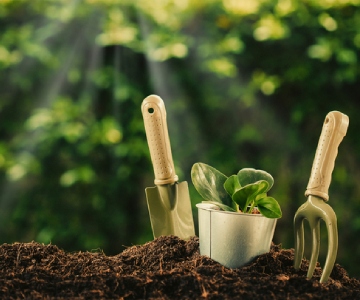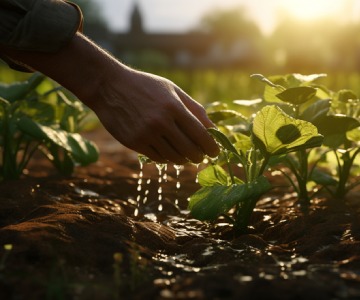Gardening is more than just growing, it is also about giving back and one of the most healthy living habits one can have. Welcome to My Garden Guides where we believe that every garden can help nature flourish. You could either be growing herbs on a balcony or cultivating a backyard, here is a blog to guide, inspire, and connect you with the natural world.
Our commitment is to help you turn your space into a haven for pollinators, birds, bugs, and biodiversity. This blog is a perfect guide for nature-first gardening. Keep reading to get seasonal advice, simple planting tips, and ways to welcome wildlife with open arms.
What Makes Gardening Nature Friendly
Gardening is friendly to nature, a practice that involves cultivating plants for various purposes and creating an aesthetically pleasing environment. It entails selecting flowers that feed pollinators, providing a shelter to little animals, and building an area that allows nature to be wild. Even a small green area may be turned into a thriving mini-ecosystem. Additionally, you do not require a great deal of money or the knowledge of a professional to begin gardening, you just need a handful of decision-making like shunning the use of pesticides and growing more native plants.

Start with Intentions
There should be a purpose when gardening. Plant with pollinators in mind, leave space for wild corners, and create spaces for wildlife to rest and thrive. Have in mind that you are growing something much bigger than just a pretty flower bed. Gardening for nature involves you:
- Supporting bees, butterflies, and beneficial insects
- Avoiding harsh chemicals
- Letting some plants go to seed for birds
- Working with the season instead of against them
Gardening with intentions is vital, especially when you consider the facts that bees are disappearing and insects are vanishing. Turning gardens into nature-friendly spaces can be part of the solution.
What You Will Find on My Garden Guides
This blog will function as your one-stop library to create a garden that will support nature all through the year. This is what we have got:
Monthly Garden Tasks: Checklists of garden tasks on a nature-focused basis are provided according to the current needs of your garden on a monthly basis. You will be informed on what and when to plant and what wildlife you can observe as well as how to take care of your plants and your soil.
Bees, butterflies and blooms: what to plant to get the most out of pollinators? Which flowers are best for bees, which herbs help butterflies, and what flowers can be planted to ensure a succession of bloom throughout the year. We supply containers, shade loving plants and lists of native species.
Wildlife Spotting and species guides: Learn which creatures live in your garden. Our wildlife experts assist you to distinguish bees, beetles, birds, and frogs among others and advise you on how to make your place even more comfortable to visit.
DIY Projects and Sustainable Tips: Our DIY-Projects will make you bring a difference easily with your own hands and on a tight budget. Our Sustainable Tips are unique and reflect our work.
Easy Ways to Start a Wildlife Garden Today
You don’t need a large garden and large investment to assist nature. These are four easy steps you can start with:

- Leave It a Jumble: Nature adores the wild. There is no need to clean up every nook and cranny. Set a heap of leaves or stack of logs in an out-of-the-way corner–pretty soon it will be alive with all manner of things.
- Add Water: one shallow dish of water with rocks is sufficient to provide safe bees a place to drink. However, even the small pond can attract frogs, dragonflies and birds.
- Plant the Right Plants: Plant single-flowered plants because they are pouring in nectars and pollen. Pollinators love lavender, marjoram, cornflowers and foxgloves. Throw in local wild flowers such as knapweed and birdsfoot trefoil.
- Stay away from Chemicals: Pesticides and manufactured fertilizers are bad to the health of soil, and the life of insects. Employ organic methods, or go in by hand and pluck the pests, or allow the natural predators (such as ladybirds) to get on with it.
These minor adjustments will help you realize that you will soon feel your garden come to life and have even greater pleasure in seeing it grow and flourish.
Gardening Through the Year
One of the most important aspects of gardening is understanding the different seasons and how they affect the plants. This will help you develop a more healthy and nature-friendly space. Additionally, certain plants react differently to different seasons and it is vital to have a good understanding of these. Every season offers opportunities to grow and give back.
🌸 Spring
This spring is when everything stirs and you should focus on blooms and clean water. It is the time to sow seeds and create bee-friendly beds. Some of the best plants that thrive this period are snowdrops, crocuses, and primroses. You will likely see some bumble queens, frogs, and blossom feeders.
☀️ Summer
The season of full bloom and buzz. This is prime pollinator season and time to keep your flowers diverse and blooming. In this season you should deadhead flowers, water during dry spells, and support late bloomers. You will also start to spot butterflies, solitary bees, and swifts.
🍂 Autumn
Autumn is where you get to resist over-tidying. It is the season to feed the soil and protect hibernators. Your job this season is to leave seed heads, build composite piles, and add logs for shelter. Watch out for spiders, migrating birds, and fungi.
❄️ Winter
You would be surprised how much your garden can provide during winter, these include food, shelter, and peace. However, this is the period where you should refill feeders, insulate ponds, and plan for spring. You also know it is winter when you start to notice birds at feeders and overwintering insects.
Our Approach
We believe in gradual, seasonal, and sustainable gardening. This involves listening to the land, growing alongside nature, giving space to insects, birds and soil health and celebrating imperfection since these are part of the ecosystem. Nothing fancy or overwhelming. You can be assured of down-to-earth and workable measures. Our goal is to help you feel confident, curious, and connected.